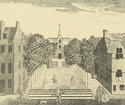 It was protests from the city's craftsmen which prevented the Cathedral being demolished in the aftermath of the Reformation. In 1579 Andrew Melville, the University Principal, and the magistrates got so far as employing workmen to raze it to the ground before being halted by the protests of the incorporated trades . For some time after 1560 it remained the only place of worship and in a poor state. But in the 1590s the building was divided into three separate churches. The west wing became the Outer High Church, the nave and choir became the Inner High Church, and the crypt became the Barony Church. The Barony's most famous minister was Zachary Boyd who survived the difficult times from 1623 until 1653.
It was protests from the city's craftsmen which prevented the Cathedral being demolished in the aftermath of the Reformation. In 1579 Andrew Melville, the University Principal, and the magistrates got so far as employing workmen to raze it to the ground before being halted by the protests of the incorporated trades . For some time after 1560 it remained the only place of worship and in a poor state. But in the 1590s the building was divided into three separate churches. The west wing became the Outer High Church, the nave and choir became the Inner High Church, and the crypt became the Barony Church. The Barony's most famous minister was Zachary Boyd who survived the difficult times from 1623 until 1653.
 The College Church, or the Church of the Blackfriars, was on the east side of the High Street near the College. Until 1763 it acted as college chapel. An earlier Church had been destroyed by fire in 1666 and the new one was built on the site in 1699. The Tron or Laigh Kirk dated from 1484 and was badly damaged at the Reformation, "purged of alterages", but it was gradually restored in the 1590s with the steeple and clock added in 1637. Just outside the town's boundary, in what was to become Ingram Street, the North-West Church was built in 1720 with John Anderson, the grandfather of the founder of the Andersonian Institute, as minister. This was the first Ramshorn Church, named after the lands on which it was built. Further east in St Andrew's Square, St Andrew's Church was built between 1739 and 1756 on the model of St Martin's-in-the-Field in London.
The College Church, or the Church of the Blackfriars, was on the east side of the High Street near the College. Until 1763 it acted as college chapel. An earlier Church had been destroyed by fire in 1666 and the new one was built on the site in 1699. The Tron or Laigh Kirk dated from 1484 and was badly damaged at the Reformation, "purged of alterages", but it was gradually restored in the 1590s with the steeple and clock added in 1637. Just outside the town's boundary, in what was to become Ingram Street, the North-West Church was built in 1720 with John Anderson, the grandfather of the founder of the Andersonian Institute, as minister. This was the first Ramshorn Church, named after the lands on which it was built. Further east in St Andrew's Square, St Andrew's Church was built between 1739 and 1756 on the model of St Martin's-in-the-Field in London.
 At different times there would have been a number of meeting places for secessionists and dissenters. It was, for example, Presbyterians, who objected to Bishops, who built the Wynd Church in 1687. Episcopalians had a chapel, which later became St Andrew's-by-the-Green, from 1750. From the 1740s the Society of Friends, or Quakers, had a meeting house in Stirling Street and the Associated Burghers, a session from the Church of Scotland, met in Shuttle Street. A handful of Catholics met, usually secretly, in a room in Saltmarket Street.
At different times there would have been a number of meeting places for secessionists and dissenters. It was, for example, Presbyterians, who objected to Bishops, who built the Wynd Church in 1687. Episcopalians had a chapel, which later became St Andrew's-by-the-Green, from 1750. From the 1740s the Society of Friends, or Quakers, had a meeting house in Stirling Street and the Associated Burghers, a session from the Church of Scotland, met in Shuttle Street. A handful of Catholics met, usually secretly, in a room in Saltmarket Street.